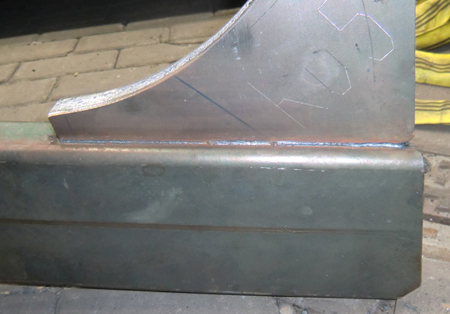25 Apr 2012
Two key Laser Zentrum Hannover developments showcased at this week's event.
Cochlear implant with external mic and speech processor
"Laser technology can improve hearing"

Hear hear: LZH's improved cochlear implant showcased at Hanover Fair.
Approximately 95% of all those who are highly hearing impaired have an adequately intact auditory nerve, enough to provide at least partial hearing. An important device for this process is a cochlear implant, and electronical acoustic aid or prosthesis, which takes over the function of damaged sensory cells in the inner ear.
This aid consists of an implant, which is placed in the bone, under the skin behind the ear, an electrode which is placed directly in the cochlea, and a microphone and speech processor, also placed behind the ear. When sound waves are registered by the microphone, they are translated into a series of electrical impulses, which are then led to the electrode on the auditory nerve in the inner ear.
The basilar membrane, which is covered by tiny sensory cells or hairs, can only provide optimal hearing if it is not damaged. If this membrane is damaged, this can lead to complete loss of residual hearing. This means that the cochlear electrode must be inserted extremely carefully, to avoid damage to the membrane.
The Surface Technology group at the LZH is working to simplify the operation and improve the insertion technique of the electrode into the complicated form of the cochlea. To achieve this, the scientists use the special properties of nickel-titanium shape memory alloys (NiTi-SMA) in manufacturing the CI electrodes.
By heating the electrode, or via electrical impulses, this material remembers the form or shape it was manufactured in, thus allowing specific movement and fitting of the electrode. On the one hand, laser melting is used to form the NiTi-SMA into a highly individual implant.
On the other hand, the special characteristics of the material can be used to insert the implant into the cochlea without damaging the basilar membrane. Basically, the deeper the material is inserted into the cochlea and the better the fit, the better hearing can be.
At the Laser Zentrum Hannover, a second approach is also being used to optimize the characteristics of cochlea implants. The group Laser Micromachining has set a goal of improving the surface of implants by using laser structuring.
“The surface of conventional cochlea implants is not subject to special treatment, and a great potential is lost! We have learned from mother nature that biological surfaces, for example of lotus leaves or shark skin, have defined structures for special function,” explains scientist Elena Fadeeva.
By using a femtosecond laser, the platinum electrodes can be structured in a special way. Special nanostructures, looking very rough when magnified, can be manufactured, which reduce attachment of connective tissue and improve interaction with the nerve cells.

Metal sandwich: LZH has laser-welded a demonstrator for marine gear.
Laser welding of large format metal-foam sandwich
Promising results for lightweight shipbuilding
The Laser Zentrum Hannover and some project partners have laser welded a demonstrator for marine gear unit foundations made of steel and aluminum foam sandwich material.
Metal foams are highly porous, lightweight materials which, due to their cellular structure, can absorb energy in the form of vibrations and knocks, or noise. They are also heat resistant and provide insulation against electromagnetic waves.
Metal foams, embedded in so-called sandwich constructions with aluminum or steel sheets, have a much higher bending stiffness than solid sheets, and due to their lower weight, are especially suitable for lightweight construction, or for highly stressed parts.
Large scale metal-foam sandwich materials are especially interesting for highly stressed ship structures such as foundations for machines, or for rudder structures, since weight reduction up to 20% is possible. However, steel-aluminum lightweight structures are difficult to weld, due to inhomogeneity of the foam core, high stiffness, and the material thicknesses.
One problem is, for example, the thermal effects of foaming the aluminum core in mixed sandwich materials, which can distort the material. Welding can also lead to intermetallic phases, causing cracks in the welding seam.
Scientists in the LZH's Joining and Cutting of Metals group have developed a process for laser welding large scale, metal-foam sandwich materials, in which intermetallic phases do not occur. Their investigations are in the framework of the joint project MESCHLAS.
This process was recently tested on a gear unit foundation at Blohm + Voss Naval GmbH in Emden. It uses a transportable axis system and a mobile diode laser, which were provided by the companies Scientific & Efficient Technologies and Laser On Demand GmbH.
As the first step, mechanical preparation of the panel edges is necessary. The aluminum foam, which adheres to the steel top sheets (S235JR) is removed, thus preventing intermetallic phases. Then the components must be exactly positioned, forming a zero gap.
Due to the size of the panels, this step is rather challenging. Following this, the sandwich panels are fixed using conventional spot welding. Laser welding of the butt welds and fillet welds then takes place, using a diode laser with a wavelength between 900 and 1030 nm and an output of 5 kW.
Tests show that a gap of 0.6 mm can be bridged, and continuous weld seams are possible. Depending on the material thickness (up to 5 mm), speeds of 0.2 to 1.5 m/min. were possible.
About the Author
Matthew Peach is a contributing editor to optics.org.
| © 2025 SPIE Europe |
|